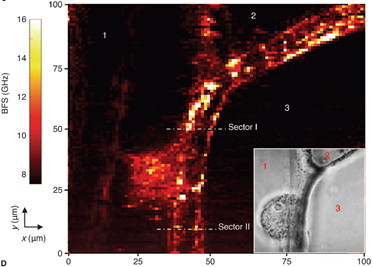Work Group 2: Phenotyping and Novel Applications in the Life Sciences
Over the last few years, there has been a boom in the implementation of Brillouin Light Scattering Spectroscopy (BLSS) in life sciences on the one side and in the appreciation of mechanical features of biological systems on the other. Despite the established capabilities of Brillouin scattering in micromechanical testing, the interpretation of the viscoelastic parameters – especially in regards to their biological relevance – that can be extracted from BLSS measurements is still to some extent debated. Given the inherently complex structure of most biological matter, this can lead to ambiguities in the interpretation of the data, as well as a lack of consensus on the potential applications, and limitations of the method.
At this stage of development of BLSS, the exact origin of the Brillouin spectrum of biomaterials needs to be clarified. Yet detailed quantitative studies of the molecular/genetic origin, as well as any associated morphological and behavioural characteristics of cellular and tissue scale high-frequency viscoelastic properties, remain largely unexplored. This workgroup (WG) will work towards correlating how genetic/biochemical variations are linked to viscoelastic properties as measured by BLSS. Reciprocally, studies of the changes in viscoelasticity that may occur throughout the developmental cycle, or brought about by other environmental perturbations are part of the scope of this WG.
Due to significant sample-to-sample variation in the mechanical properties and the sensitivity of BLSS to experimental and environmental conditions, a focus will be on collating results between labs to achieve statistically significant conclusions. Such large scale action will require the development of standardized protocols, biological materials and methods shared between all participants. It will also involve more research effort being focused onto cellular analysis at the level of single cell imaging, e.g. through microfluidic devices. For this, a strong entwinement with WG3 (Instrument design and data analysis) is expected.
During the course of the WG, BLSS will become increasingly relevant in correlating molecular processes and viscoelastic properties. A longer term goal of BioBrillouin is to establish BLSS as a routine tool in diagnostics and theranostics for medical conditions associated with changes in the cellular or tissue level mechanical properties, as well as to investigate its potential for non-invasive early diagnosis of degenerative diseases which are known to be associated with changes in mechanical properties. This WG is thus also intended to provide a platform for exploring such applications with collaborators working on disease diagnostics in collaboration with WG1 (Medical and Clinical Applications).
Literature
Scarcelli et al., Nat Meth 12 (2015): cytochalasin is shown to affect Brillouin shift as it fluidises the cytoskeleton network within the cell.
Zhang et al., Lab Chip 17 (2017): coupling BLSS and microfluidics for mechanical phenotyping of the nucleus.
Elsayad et al., Sci Sig 9 (2016): coupling fluorescence emission and Brillouin scattering imaging to probe Arabidopsis thaliana mutants
Focus points:
- Phenotyping (genetic, developmental, behavioural).
- Novel applications of BLSS in biology.
- Protocol, data/result standardization and interpretation.
- Establishment of online database of Brillouin spectra.
To contribute to this Work Group you can join the Action (membership questionaire) and also use the Sample and Personnel Exchange (SAPE) porthole to arrange sample/personnel exchange (which will be available from October 2017). For more information, please contact:
Work Group Leader: Dr. Thomas Dehoux Institut Lumière Matière, France (thomas.dehoux[at]univ-lyon1.fr) Other contact points: Dr. Jeremie Margueritat Institut Lumiere Matiere, France (jeremie.margueritat[at]univ-lyon1.fr)


